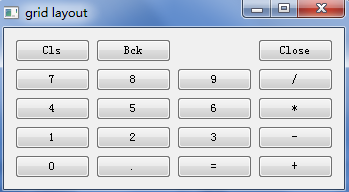import sys from PyQt4 import QtCore, QtGui class MainWindow(QtGui.QWidget): def __init__(self, parent = None): QtGui.QWidget.__init__(self) self.setWindowTitle('grid layout') names = ['Cls', 'Bck', '','Close', '7', '8', '9', '/', '4', '5', '6', '*', '1', '2', '3','-','0','.', '=', '+'] grid = QtGui.QGridLayout() # 创建一个网格布局 j = 0 pos = [(0,0), (0,1), (0,2), (0,3), (1,0), (1,1), (1,2), (1,3), (2,0), (2,1), (2,2), (2,3), (3,0), (3,1), (3,2), (3,3), (4,0), (4,1), (4,2), (4,3)] for i in names: button = QtGui.QPushButton(i) if j == 2: grid.addWidget(QtGui.QLabel(''), 0, 2) # 填补Back和Close按钮之间的空格,使用QLabel部件 else: grid.addWidget(button, pos[j][0], pos[j][1]) # 使用addWidget()方法,将部件添加到网格布局中 j = j + 1 self.setLayout(grid) app = QtGui.QApplication(sys.argv) main = MainWindow() main.show() sys.exit(app.exec_())
